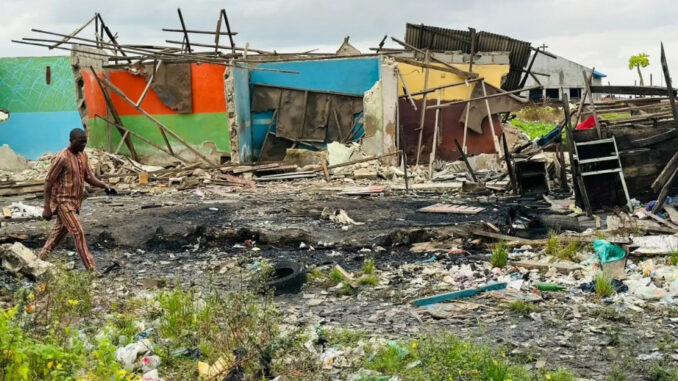
As another example, it was reported in the media that at the Supreme Court, Abuja, in the year 2002, The Lagos state government through the then Lagos state Commissioner for Justice, Professor Yemi Osinbajo, immediate past Vice President of Nigeria, accepted responsibility for demolishing Maroko community and promised the evictees 1,000 housing units every year, till the whole former house-owners of Maroko are fully resettled.
He admitted that though, government acquired Maroko town in 1972, it again relinquished the acquisition in 1977; thereby confirming that Maroko was not under government acquisition when it was demolished in 1990. But regrettably, till this day, nothing has been done by the state government or his agents to remedy the situation or fulfill the promise made.
The above sad account is an emblem of governments that are unmindful of, or deliberately decided to ignore the clarification by the United Nations Independent Expert on the Right to Development, which among other remarks noted that for a programme to be tagged development, it must require a particular process that allows the realization of economic, social and cultural rights, as well as civil and political rights, and all fundamental freedoms, by expanding the capabilities and choices of the individual.
In similar vein, the international convention on Economic, Social and Cultural Rights (Ratified by Nigeria in 1993), is one document that probably did more than anything else to capture the gully of disappointments and many sins of successive administrations in the state against the evictees.
It recognised that globally, forced eviction is a brazen violation of the right to life, right to fair hearing, right to dignity of the human person, the right to a private and family life, and the rights to property guaranteed by the constitution of the Federal Republic of Nigeria, and the African charter of Human and peoples’ Right (Ratification and Enforcement Act 1990). Similarly, the United Nations Human Rights Commission Resolutions 1993/77 and 2004/28 affirm that when forced evictions are carried out, they violate a range of internationally recognised human rights.
These include the Human right to adequate housing; Human rights to security of the person, and security of the home; Human right to health; Human right to food; Human right to water; Human right to work/livelihood; Human right to education; Human right to freedom from cruel, inhuman and degrading treatment; Human right to freedom of movement; Human right to information; and, Human right to participation and self-expression.
While it has been reported repeatedly that clearance operations should take place only when conservation arrangements and rehabilitation are not feasible, relocation measures stand made, UN Resolution 2004/28, recognized the provisions on forced evictions contained in the Habitat Agenda of 1996, and recommended that, “All Governments must ensure that any eviction that is otherwise deemed lawful is carried out in a manner that does not violate any of the human rights of those evicted.” It will be highly rewarding if the state government internalizes these provisions and develops processes or processes that allow the realization of economic, social development of the state in a way that protects the rights of the people.
Broadly speaking, from the above accounts, it is evident that the practice of forced eviction by state actors remains a sad account of, or a symbol of governments that have consciously decided to flagrantly ignore global framework on physical planning of livable neighborhood, slum upgrade and urban regeneration.
To further buttress this claim, let’s cast a glance at how a ‘famous’ slum challenge was creatively handled in Rio de Janeiro, Brazil, without displacement or eviction of the original occupants. Instead of removing the favelas,- a people initially considered/described as illegal occupants, many of the government’s policies were made to focus more on improving the infrastructure of the people/the area. The Inter-American Development Bank for example, funded a US$180 million “slum to neighborhood” project in 1995, which sought to integrate existing favelas into the fabric of the city through infrastructure upgrading and service development.
The project involved 253,000 residents in 73 favela neighborhoods in Rio de Janeiro. When a favela was selected, a master plan for upgrades was drafted and community organizations were contacted and asked to provide their input. When the final plan was approved, incentive plans were implemented for hiring construction companies that employed local community workers.
From Brazil to Spain and South Africa, the story and experience is the same. Comparatively, when one juxtaposes the above accounts as recorded in Brazil, with that of July 1990 Maroko’s experience, there exists a gully of difference. Essentially, aside from the imperative of drawing useful lessons from Brazil experience, this piece would also appreciate the Lagos state government explain whose responsibility is it to provide infrastructures; government or the people/residents?
For me, providing answer(s) to the above question will redefine as well as address government’s relationships with the people on issues of physical planning and urban re-generation, usher in eviction-free co-existence while sending new lessons to other states in the country and of course the Federal Government reputed for practices of forced evictions.
Concluded
Utomi is the Programme Coordinator (Media and Policy), Social and Economic Justice Advocacy (SEJA), Lagos.
He could be reached via: jeromeutomi@yahoo.com /08032725374


Be the first to comment